Impacts of Occupant Behavior on Building Energy Consumption and Energy Savings Analysis of Upgrading ASHRAE 90.1 Energy Efficiency Standards
Abstract
:1. Introduction
- Three occupant behavior styles (austerity, normal, and wasteful) were defined based on the energy consciousness levels of the occupants regarding their interactions with the lighting, equipment, and heating/cooling setpoint systems. The DOE medium office prototype models were used as the baseline case (with normal behavior style). The obFMU was used to model the stochastic occupant behaviors, including the occupant movement and two interaction behavior styles (austerity and wasteful).
- The EnergyPlus medium office prototype models for the 2016 and 2019 editions across sixteen U.S. climate zones were modified to co-simulate with the obFMU models.
- After verifying the effectiveness of the occupant behavior models, the impacts of the stochastic occupant behavior on the building energy consumption and the energy savings analysis from upgrading the ASHRAE 90.1-2016 to 2019 were analyzed.
2. Methodology
2.1. Framework Overview
2.2. DOE Medium Office Building Models
2.3. Occupant Behavior Models
2.3.1. obXML
2.3.2. Occupant Movement Model
2.3.3. Occupant Interaction Models
- Interior lighting model
- 2.
- Interior equipment model
- 3.
- Thermostat setpoint model
2.4. The Development of the obXML-Generator
2.5. The Co-Simulation between EnergyPlus and obFMU
3. Results
3.1. Simulation Repetition
3.2. Model Verification
3.2.1. The Verification of the Occupant Movement Model
3.2.2. The Verification of the Occupant Interaction Model
3.3. Results Analysis
4. Discussion
- This study focused on the impacts of stochastic occupant behaviors on building energy performance. The stochastic occupant behavior models (austerity, normal, and wasteful) were defined, and the impacts of each occupant behavior model on the building energy performance were analyzed. However, there are many important parameters that significantly impact the building energy performance, such as the air infiltrations [49], the coefficient of performance (COP) of the VAV direct expansion (DX) cooling coil, and the conductance and the solar heat gain coefficient (SHGC) of windows [50], and so on. Many of these parameters were well-considered in the existing prototype building models in sixteen climate zones in the U.S. and thus were not discussed in this study. Table 10 presents the design parameters of the DOE medium office building models in Seattle for different editions of ASHRAE 90.1.
- Occupancy and their behaviors all had significant impacts on the building energy consumption. However, it is very difficult to define the low-occupancy and high-occupancy cases, as it will bring more questions than the problem solved. Thus, this study focused only on the impacts of different occupant interaction behaviors with the stochastic and same occupancy.
- This study only considered the occupant activities in the building operation stage. More comprehensive factors such as socio-economic characteristics, geographical location, subjective values, individual and collective adaptive action, and the optimization control of building energy systems [51] are needed to be integrated into occupant behavior models; therefore, more representative, synthetic occupants [52,53] can be generated.
- This study only divided each thermal zone into four-person rooms to improve the DOE medium office building models. A field survey of room types in office buildings will be conducted to add more room types in the future study. Moreover, ORNL’s building models have significant meaning in defining the space type of the DOE building models and occupant behavior models. We will refine our study if the ORNL’s building models replace the DOE’s.
- The five zones in each floor in the DOE medium office building models were served by an air conditioner system. These zones, therefore, were defined as open-plan office spaces in this study. The HVAC systems were kept running during office hours all year round, so this study did not consider the HVAC zonal on/off control and window zonal open/close behaviors. Private offices will be considered in the prototype building models, and the occupant behavior models will be improved in the next work.
- The use of shade systems can impact the use of artificial lighting, thus affecting the building energy consumption [54,55]. The shading control behaviors in the open-plan offices were more complex than in the private offices. There were more manually-operated shade behavior models that could be referred to in private offices than in open-plan offices [55,56,57]. Therefore, this study did not consider the stochastic shading control behaviors. We are collecting parameters such as the work plane illumination and occupancy schedule in the office buildings through measurement and expect to construct shade control behavior models in the future.
5. Conclusions
- The occupancy of the co-simulation model (with stochastic occupant movement behavior) was consistent with that of the DOE prototype model (with deterministic occupant movement behavior) at the building level.
- The stochastic occupant behavior significantly impacted the building energy use. Compared with the normal behavior style in 2016 and 2019, the austerity behavior style consumed 25% less site energy and 29% less source energy, while the wasteful behavior style consumed 32% more site energy and 36% more source energy.
- The impacts of the stochastic occupant behaviors on the energy savings from upgrading ASHRAE 90.1 were also not negligible. The different occupant behavior styles had different impacts on the ASHRAE 90.1 energy savings. From upgrading the ASHRAE 90.1-2016 to 2019, the source energy savings were 5.59%, 4.78%, and 4.42% for the austerity, normal, and wasteful behavior styles. Although the impacts of the stochastic occupant behaviors on the energy savings of the DOE medium office models were slight, it will also be conducive to the energy conservation of high energy-consuming buildings to a certain extent. In summary, it is necessary to consider the diversity, stochasticity, and dynamics of occupant behavior when updating the building energy efficiency standards.
Author Contributions
Funding
Conflicts of Interest
References
- Xue, Q.; Wang, Z.; Chen, Q. Multi-Objective Optimization of Building Design for Life Cycle Cost and CO2 Emissions: A Case Study of a Low-Energy Residential Building in a Severe Cold Climate. Build. Simul. 2022, 15, 83–98. [Google Scholar] [CrossRef]
- Skea, J.; Shukla, P.R.; Reisinger, A.; Slade, R.; Pathak, M.; Khourdajie, A.A.; Diemen, R.V.; Abdulla, A.; Akimoto, K.; Babiker, M.; et al. Climate Change 2022: Mitigation of Climate Change. Contribution of Working Group III to the Sixth Assessment Report of the Intergovernmental Panel on Climate Change; Intergovernmental Panel on Climate Change (IPCC): Cambridge, UK, 2022. [Google Scholar]
- Melo, A.P.; Sorgato, M.J.; Lamberts, R. Building Energy Performance Assessment: Comparison between ASHRAE Standard 90.1 and Brazilian Regulation. Energy Build. 2014, 70, 372–383. [Google Scholar] [CrossRef]
- Prototype Building Models. Available online: https://www.energycodes.gov/prototype-building-models (accessed on 6 July 2022).
- Commercial Reference Buildings. Available online: https://www.energy.gov/eere/buildings/commercial-reference-buildings (accessed on 6 July 2022).
- Deru, M.; Field, K.; Studer, D.; Benne, K.; Griffith, B.; Torcellini, P.; Liu, B.; Halverson, M.; Winiarski, D.; Rosenberg, M.; et al. US Department of Energy Commercial Reference Building Models of the National Building Stock; National Renewable Energy Laboratory: Cole Boulevard Golden, CO, USA, 2011. [Google Scholar]
- Hormigos-Jimenez, S.; Padilla-Marcos, M.A.; Meiss, A.; Gonzalez-Lezcano, R.A.; Feijó-MuÑoz, J. Experimental Validation of the Age-of-the-Air CFD Analysis: A Case Study. Sci. Technol. Built Environ. 2018, 24, 994–1003. [Google Scholar] [CrossRef]
- Yoshino, H.; Hong, T.; Nord, N. IEA EBC Annex 53: Total Energy Use in Buildings—Analysis and Evaluation Methods. Energy Build. 2017, 152, 124–136. [Google Scholar] [CrossRef] [Green Version]
- Nisiforou, O.A.; Poullis, S.; Charalambides, A.G. Behaviour, Attitudes and Opinion of Large Enterprise Employees with Regard to Their Energy Usage Habits and Adoption of Energy Saving Measures. Energy Build. 2012, 55, 299–311. [Google Scholar] [CrossRef]
- Uddin, M.N.; Wei, H.-H.; Chi, H.L.; Ni, M. Influence of Occupant Behavior for Building Energy Conservation: A Systematic Review Study of Diverse Modeling. Buildings 2021, 11, 41. [Google Scholar] [CrossRef]
- Yfanti, S.; Sakkas, N.; Karapidakis, E. An Event-Driven Approach for Changing User Behaviour towards an Enhanced Building’s Energy Efficiency. Buildings 2020, 10, 183. [Google Scholar] [CrossRef]
- Jia, M.; Srinivasan, R.; Ries, R.J.; Bharathy, G.; Weyer, N. Investigating the Impact of Actual and Modeled Occupant Behavior Information Input to Building Performance Simulation. Buildings 2021, 11, 32. [Google Scholar] [CrossRef]
- Lu, X.; Feng, F.; Pang, Z.; Yang, T.; O’Neill, Z. Extracting Typical Occupancy Schedules from Social Media (TOSSM) and Its Integration with Building Energy Modeling. Build. Simul. 2021, 14, 25–41. [Google Scholar] [CrossRef]
- Deng, Z.; Chen, Y.; Yang, J.; Chen, Z. Archetype Identification and Urban Building Energy Modeling for City-Scale Buildings Based on GIS Datasets. Build. Simul. 2022, 15, 1547–1559. [Google Scholar] [CrossRef]
- Chen, Y.; Yang, C.; Pan, X.; Yan, D. Design and Operation Optimization of Multi-Chiller Plants Based on Energy Performance Simulation. Energy Build. 2020, 222, 110100. [Google Scholar] [CrossRef]
- Chen, Z.; Masood, M.K.; Soh, Y.C. A Fusion Framework for Occupancy Estimation in Office Buildings Based on Environmental Sensor Data. Energy Build. 2016, 133, 790–798. [Google Scholar] [CrossRef]
- Ahmed, K.; Akhondzada, A.; Kurnitski, J.; Olesen, B. Occupancy Schedules for Energy Simulation in New PrEN16798-1 and ISO/FDIS 17772-1 Standards. Sustain. Cities Soc. 2017, 35, 134–144. [Google Scholar] [CrossRef] [Green Version]
- Norouziasl, S.; Jafari, A.; Wang, C.; Turner, B.S.; Management, C.; Hall, P.F.T.; Rouge, B. An Agent-Based Simulation of Occupancy Schedule in Office Buildings. Build. Environ. 2020, 186, 107352. [Google Scholar] [CrossRef]
- Sun, K.; Hong, T. A Framework for Quantifying the Impact of Occupant Behavior on Energy Savings of Energy Conservation Measures. Energy Build. 2017, 146, 383–396. [Google Scholar] [CrossRef] [Green Version]
- Jami, S.; Forouzandeh, N.; Zomorodian, Z.S.; Tahsildoost, M.; Khoshbakht, M. The Effect of Occupant Behaviors on Energy Retrofit: A Case Study of Student Dormitories in Tehran. J. Clean. Prod. 2021, 278, 123556. [Google Scholar] [CrossRef]
- He, Z.; Hong, T.; Chou, S.K. A Framework for Estimating the Energy-Saving Potential of Occupant Behaviour Improvement. Appl. Energy 2021, 287, 116591. [Google Scholar] [CrossRef]
- Ma, Y.; Deng, W.; Xie, J.; Heath, T.; Xiang, Y.; Hong, Y. Generating Prototypical Residential Building Geometry Models Using a New Hybrid Approach. Build. Simul. 2022, 15, 17–28. [Google Scholar] [CrossRef]
- Yan, D.; Zhou, X.; An, J.; Kang, X.; Bu, F.; Chen, Y.; Pan, Y.; Gao, Y.; Zhang, Q.; Zhou, H.; et al. DeST 3.0: A New-Generation Building Performance Simulation Platform. Build. Simul. 2022, 1, 83–98. [Google Scholar] [CrossRef]
- Reinhart, C.F. Lightswitch-2002: A Model for Manual and Automated Control of Electric Lighting and Blinds. Sol. Energy. 2004, 77, 15–28. [Google Scholar] [CrossRef] [Green Version]
- Wang, C.; Yan, D.; Jiang, Y. A Novel Approach for Building Occupancy Simulation. Build. Simul. 2011, 4, 149–167. [Google Scholar] [CrossRef]
- Goldstein, R.; Tessier, A.; Khan, A. Schedule-Calibrated Occupant Behavior Simulation. In Proceedings of the Spring Simulation Multiconference, Orlando, FL, USA, 11–15 April 2010. [Google Scholar]
- Chen, Y.; Hong, T.; Luo, X. An Agent-Based Stochastic Occupancy Simulator. Build. Simul. 2018, 11, 37–49. [Google Scholar] [CrossRef] [Green Version]
- Hunt, D.R.G. Predicting Artificial Lighting Use—A Method Based upon Observed Patterns of Behaviour. Light. Res. Technol. 1980, 12, 7–14. [Google Scholar] [CrossRef]
- Wang, C.; Yan, D.; Sun, H.; Jiang, Y. A Generalized Probabilistic Formula Relating Occupant Behavior to Environmental Conditions. Build. Environ. 2016, 95, 53–62. [Google Scholar] [CrossRef]
- Nicol, J.F. Characterising Occupant Behavior in Buildings: Towards a Stochastic Model of Occupant Use of Windows, Lights, Blinds Heaters and Fans. In Proceedings of the Seventh International IBPSA Conference, Rio, Brazil, 13–15 August 2001. [Google Scholar]
- Haldi, F.; Robinson, D. On the Behaviour and Adaptation of Office Occupants. Build. Environ. 2008, 43, 2163–2177. [Google Scholar] [CrossRef]
- Yun, G.Y.; Steemers, K. Time-Dependent Occupant Behaviour Models of Window Control in Summer. Build. Environ. 2008, 43, 1471–1482. [Google Scholar] [CrossRef]
- Zhang, Y.; Barrett, P. Factors Influencing the Occupants’ Window Opening Behaviour in a Naturally Ventilated Office Building. Build. Environ. 2012, 50, 125–134. [Google Scholar] [CrossRef]
- Hong, T.; Sun, H.; Chen, Y.; Taylor-Lange, S.C.; Yan, D. An Occupant Behavior Modeling Tool for Co-Simulation. Energy Build. 2016, 117, 272–281. [Google Scholar] [CrossRef] [Green Version]
- ANSI/ASHRAE Standard 90.1-2016; Energy Standard for Buildings Except Low-Rise Residential Buildings. American Society of Heating, Refrigerating and Air Conditioning Engineers (Atlanta, Georgia). ASHRAE: New York, NY, USA, 2016.
- ANSI/ASHRAE Standard 90.1-2019; Energy Standard for Buildings except Low-Rise Residential Buildings. American Society of Heating, Refrigerating and Air Conditioning Engineers (Atlanta, Georgia). ASHRAE: New York, NY, USA, 2019.
- Piljae, I.; Joshua, R.; New, Y.B. Updated OpenStudio Small and Medium Office Prototype Models. In Proceedings of the 16th Conference of IBPSA, Rome, Italy, 2–4 September 2019. [Google Scholar]
- Thornton, B.A.; Rosenberg, M.I.; Richman, E.E.; Wang, W.; Xie, Y.; Zhang, J.; Cho, H.; Mendon, V.V.; Athalye, R.A.; Liu, B.; et al. Achieving the 30% Goal: Energy and Cost Savings Analysis of ASHRAE Standard 90.1-2010 (No. PNNL-20405); Pacific Northwest Natl. Lab.(PNNL): Richland, WA, USA, 2011. [Google Scholar]
- Halverson, M.; Rosenberg, W.M.; Wang, J.; Zhang, V.; Mendon, R.; Athalye, Y.; Xie, R.; Hart, S.G. ANSI/ASHRAE/IES Standard 90.1-2013. Determination of Energy Savings: Quantitative Analysis (No. PNNL-23481); Pacific Northwest Natl. Lab. (PNNL): Richland, WA, USA, 2014. [Google Scholar]
- ANSI/ASHRAE Standard 169-2013; Climatic Data for Building Design Standards. American Society of Heating. Refrigerating and Air Conditioning Engineers (Atlanta, Georgia). ASHRAE: New York, NY, USA, 2013.
- Hong, T.; D’Oca, S.; Turner, W.J.N.; Taylor-Lange, S.C. An Ontology to Represent Energy-Related Occupant Behavior in Buildings. Part I: Introduction to the DNAs Framework. Build. Environ. 2015, 92, 764–777. [Google Scholar] [CrossRef] [Green Version]
- Itron. Database for Energy Efficiency Resources (DEER) Update Study Final Report; Southern California Edison: Rosemead, CA, USA, 2005. [Google Scholar]
- Stazi, F.; Naspi, F.; Orazio, M.D. A Literature Review on Driving Factors and Contextual Events Influencing Occupants’ Behaviours in Buildings. Build. Environ. 2017, 118, 40–66. [Google Scholar] [CrossRef]
- Sun, K.; Hong, T. A Simulation Approach to Estimate Energy Savings Potential of Occupant Behavior Measures. Energy Build. 2017, 136, 43–62. [Google Scholar] [CrossRef] [Green Version]
- Wang, C. Simulation Research on Occupant Energy-Related Behaviors in Building. Ph.D. Thesis, Tsinghua University, Beijing, China, November 2014. [Google Scholar]
- Feng, X.; Yan, D.; Wang, C. On the Simulation Repetition and Temporal Discretization of Stochastic Occupant Behaviour Models in Building Performance Simulation. J. Build. Perform. Simul. 2017, 10, 612–624. [Google Scholar] [CrossRef]
- ANSI/ASHRAE Standard 14-2014; Measurement of Energy, Demand, and Water Savings. American Society of Heating, Refrigerating and Air Conditioning Engineers (Atlanta, Georgia). ASHRAE: New York, NY, USA, 2014.
- Athalye, R.; Halverson, M.; Rosenberg, M.; Liu, B.; Zhang, J.; Hart, R.; Mendon, V.; Goel, S.; Chen, Y.; Xie, Y.; et al. Energy Savings Analysis: ANSI/ASHRAE/IES Standard 90.1-2016 (No. DOE/EE-1614); Pacific Northwest Natl. Lab. (PNNL): Richland, WA, USA, 2017. [Google Scholar]
- Alfano, D.F.R.; Dell’Isola, M.; Ficco, G.; Tassini, F. Experimental Analysis of Air Tightness in Mediterranean Buildings Using the Fan Pressurization Method. Build. Environ. 2012, 53, 16–25. [Google Scholar] [CrossRef]
- Lee, C.; Won, J. Analysis of Combinations of Glazing Properties to Improve Economic Efficiency of Buildings. J. Clean. Prod. 2017, 166, 181–188. [Google Scholar] [CrossRef]
- Chen, Z.; Chen, Y.; Yang, C. Impacts of Large Chilled Water Temperature Difference on Thermal Comfort, Equipment Sizes, and Energy Saving Potential. J. Build. Eng. 2022, 49, 104069. [Google Scholar] [CrossRef]
- Putra, H.C.; Andrews, C.; Hong, T. Generating Synthetic Occupants for Use in Building Performance Simulation. J. Build. Perform. Simul. 2021, 14, 712–729. [Google Scholar] [CrossRef]
- Putra, H.C.; Hong, T.; Andrews, C. An Ontology to Represent Synthetic Building Occupant Characteristics and Behavior. Autom. Constr. 2021, 125, 103621. [Google Scholar] [CrossRef]
- Xiong, J.; Tzempelikos, A.; Bilionis, I.; Karava, P. A Personalized Daylighting Control Approach to Dynamically Optimize Visual Satisfaction and Lighting Energy Use. Energy Build. 2019, 193, 111–126. [Google Scholar] [CrossRef]
- Ding, Y.; Ma, X.; Wei, S.; Chen, W. A Prediction Model Coupling Occupant Lighting and Shading Behaviors in Private Offices. Energy Build. 2020, 216, 109939. [Google Scholar] [CrossRef]
- O’Brien, W.; Kapsis, K.; Athienitis, A.K. Manually-Operated Window Shade Patterns in Office Buildings: A Critical Review. Build. Environ. 2013, 60, 319–338. [Google Scholar] [CrossRef]
- Sadeghi, S.A.; Awalgaonkar, N.M.; Karava, P.; Bilionis, I. A Bayesian Modeling Approach of Human Interactions with Shading and Electric Lighting Systems in Private Offices. Energy Build. 2017, 134, 185–201. [Google Scholar] [CrossRef] [Green Version]
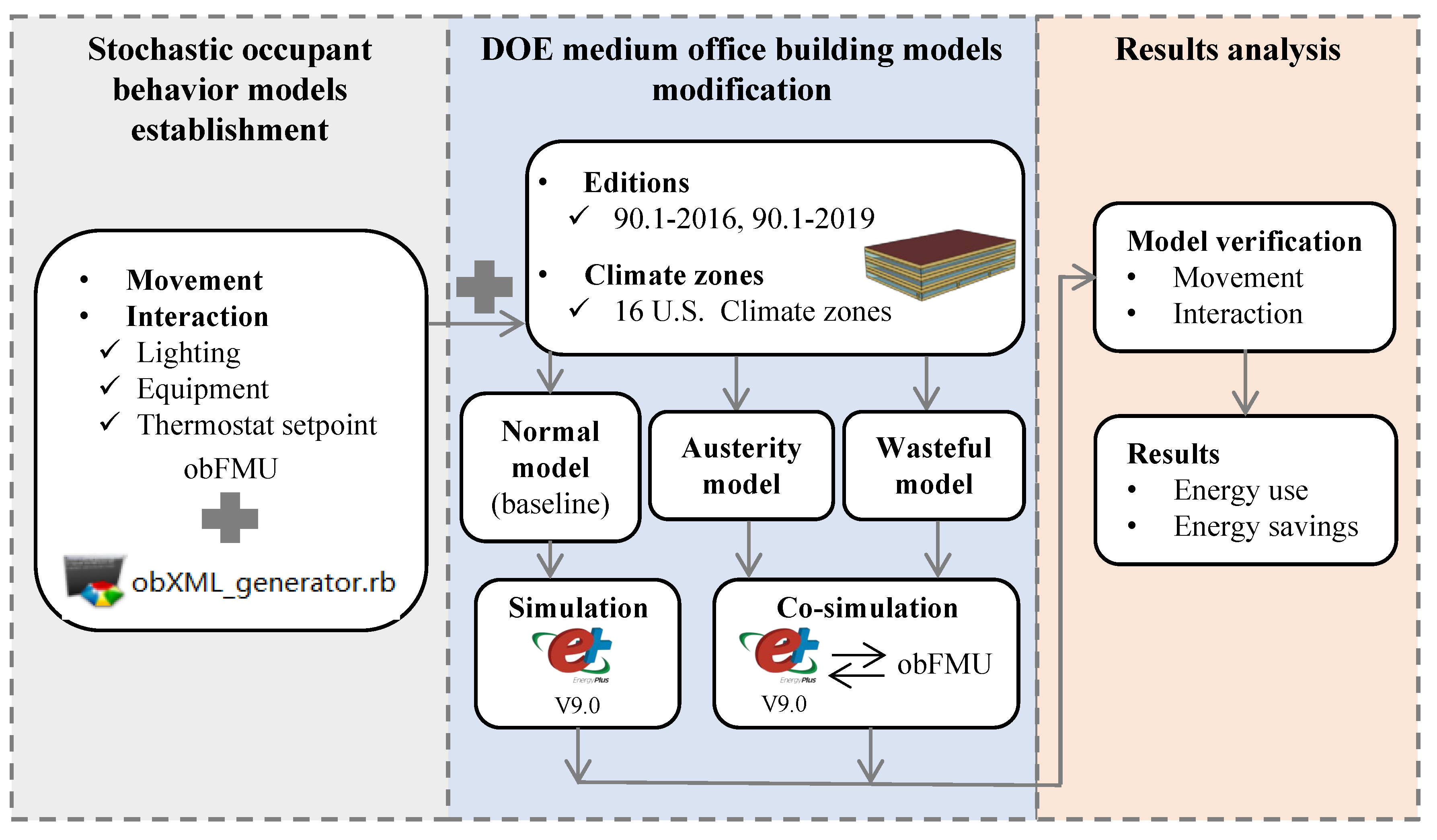
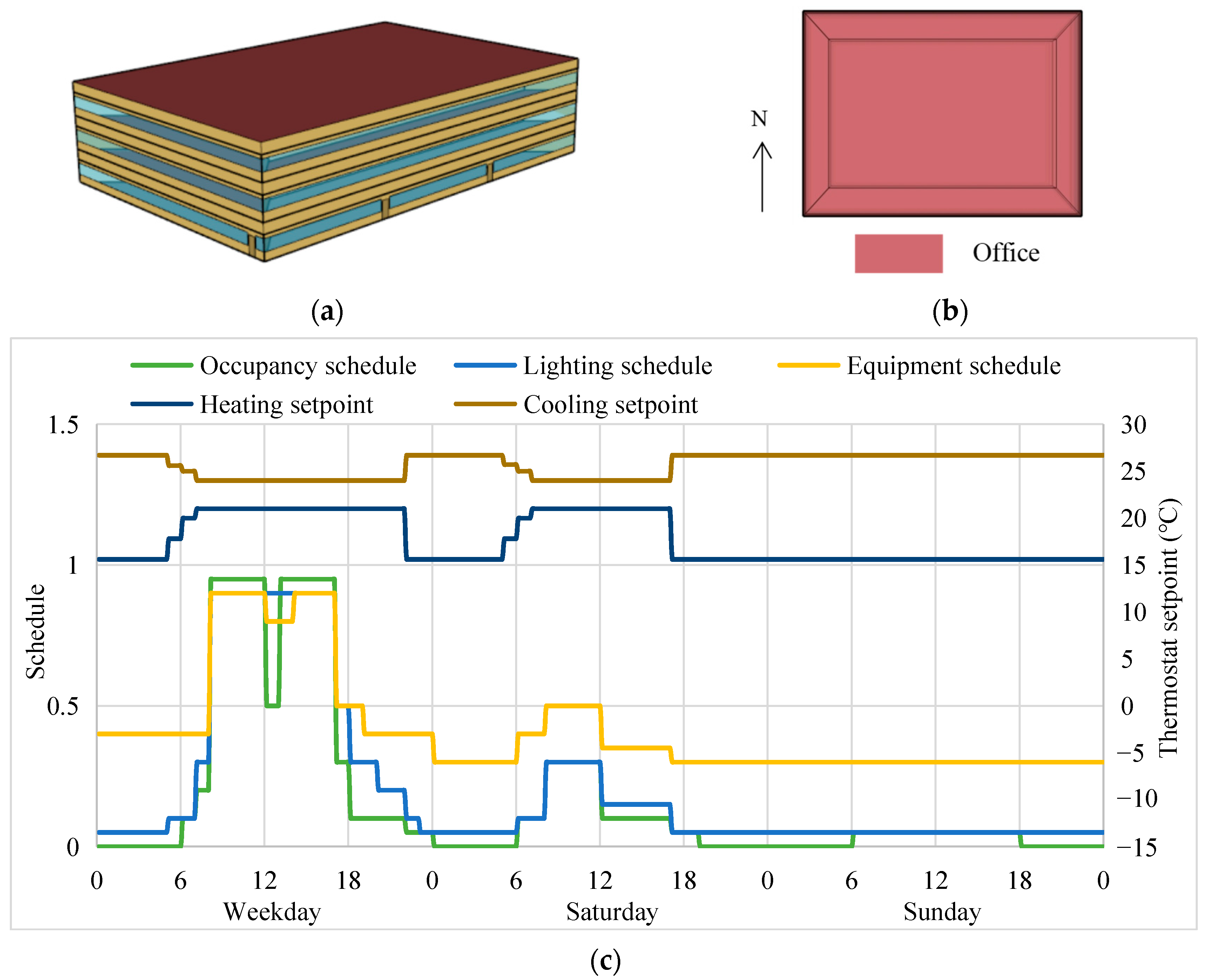

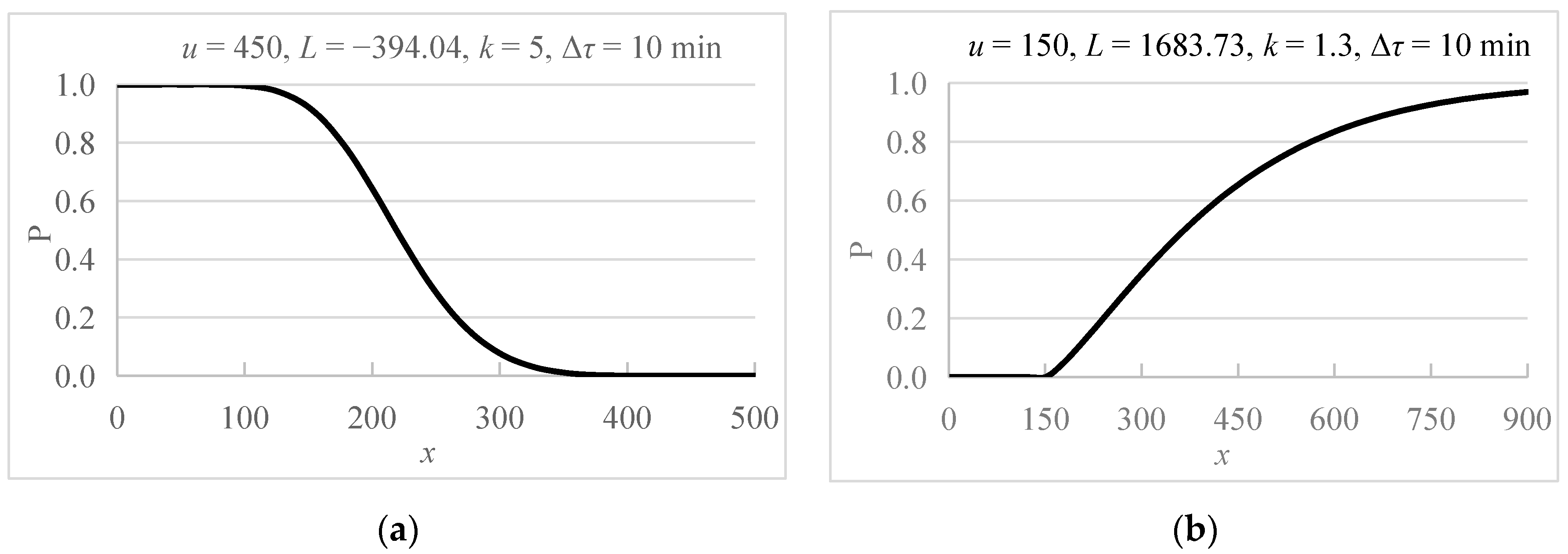
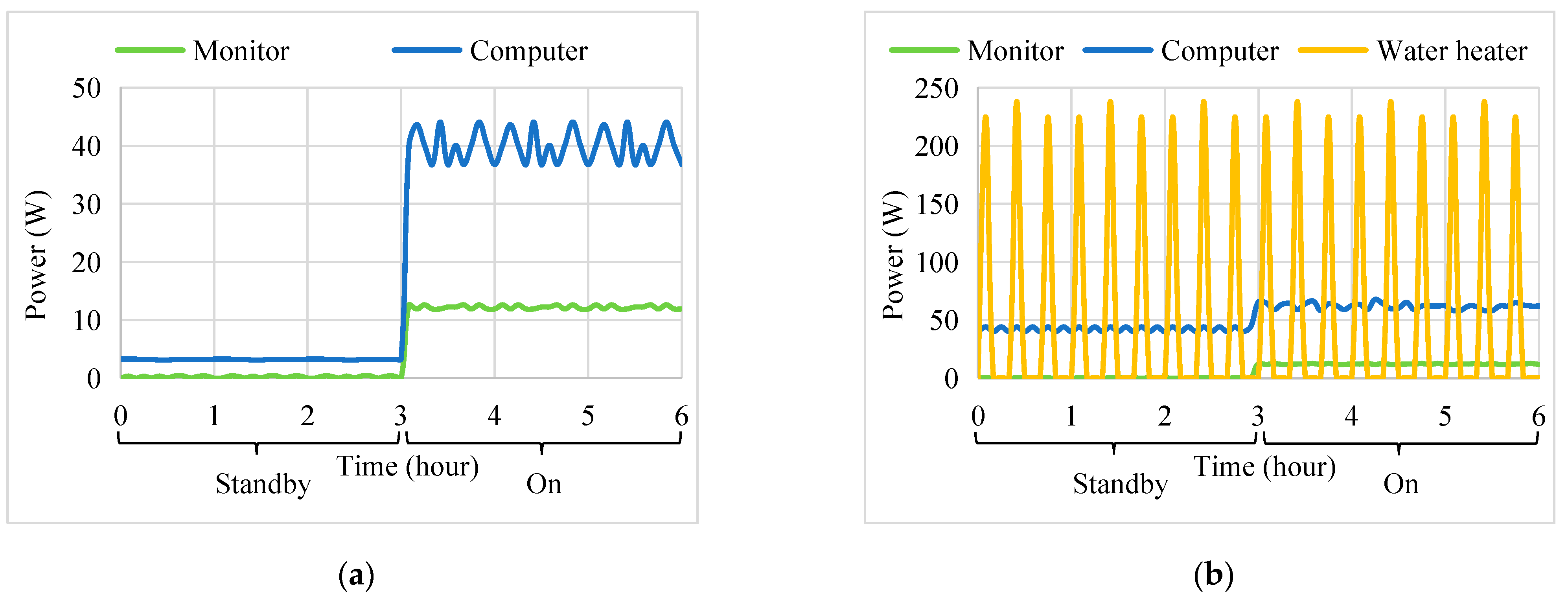


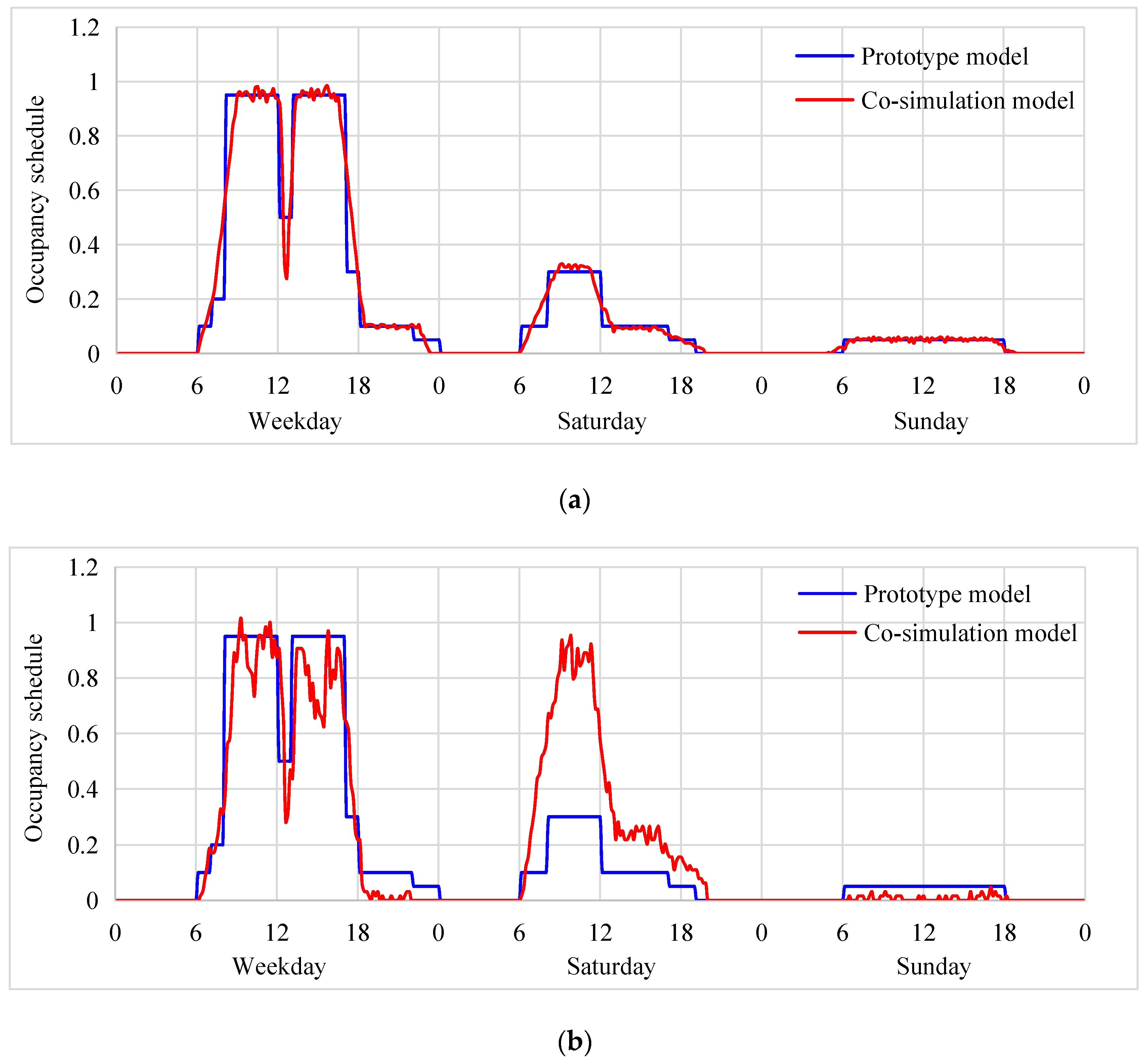
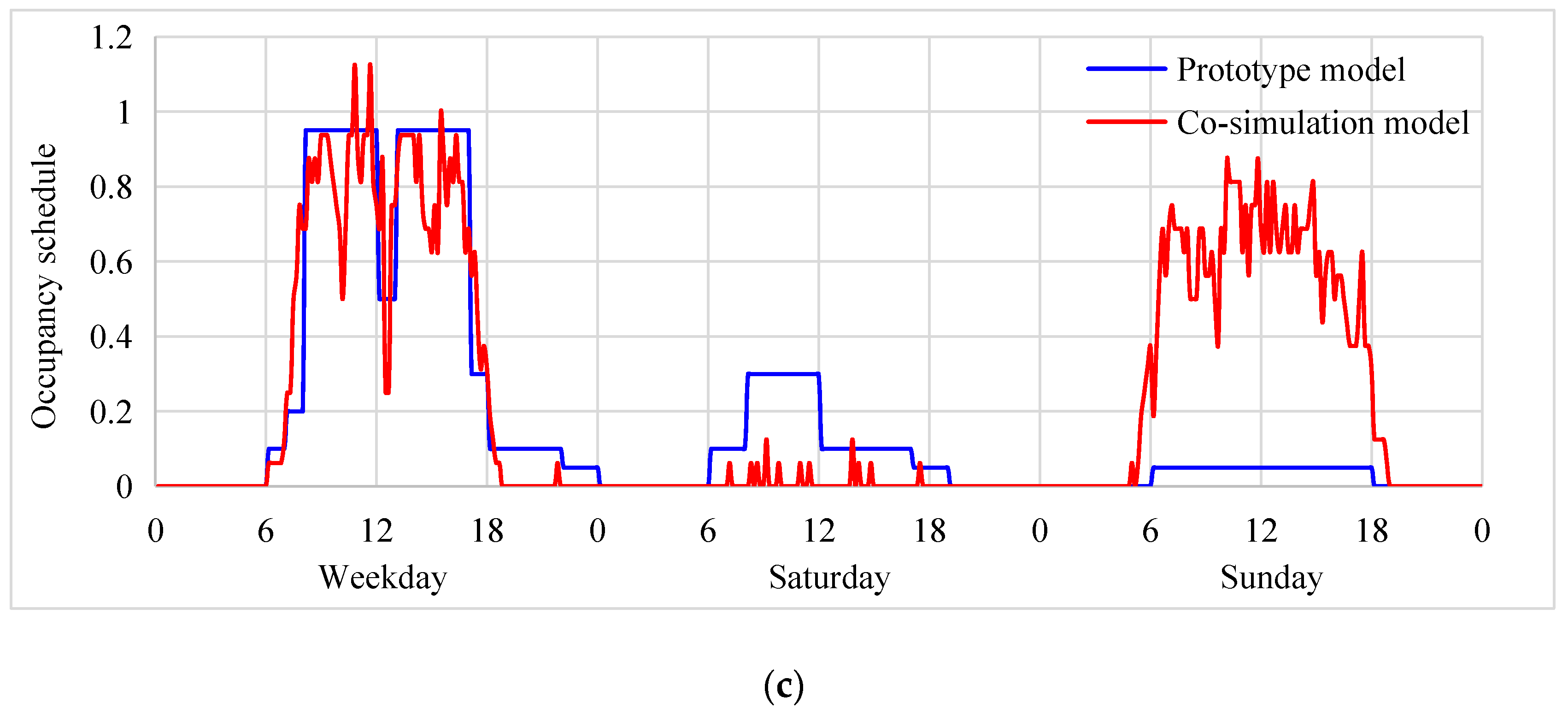
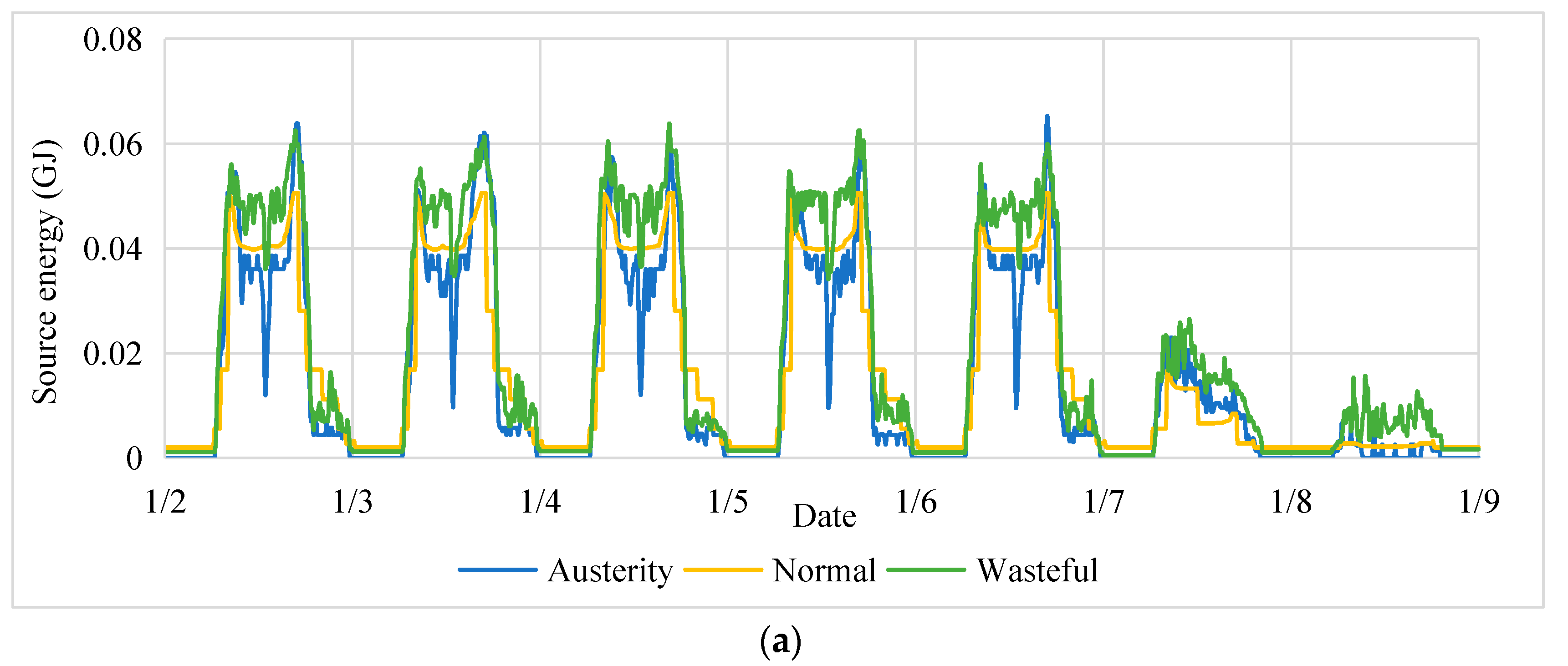
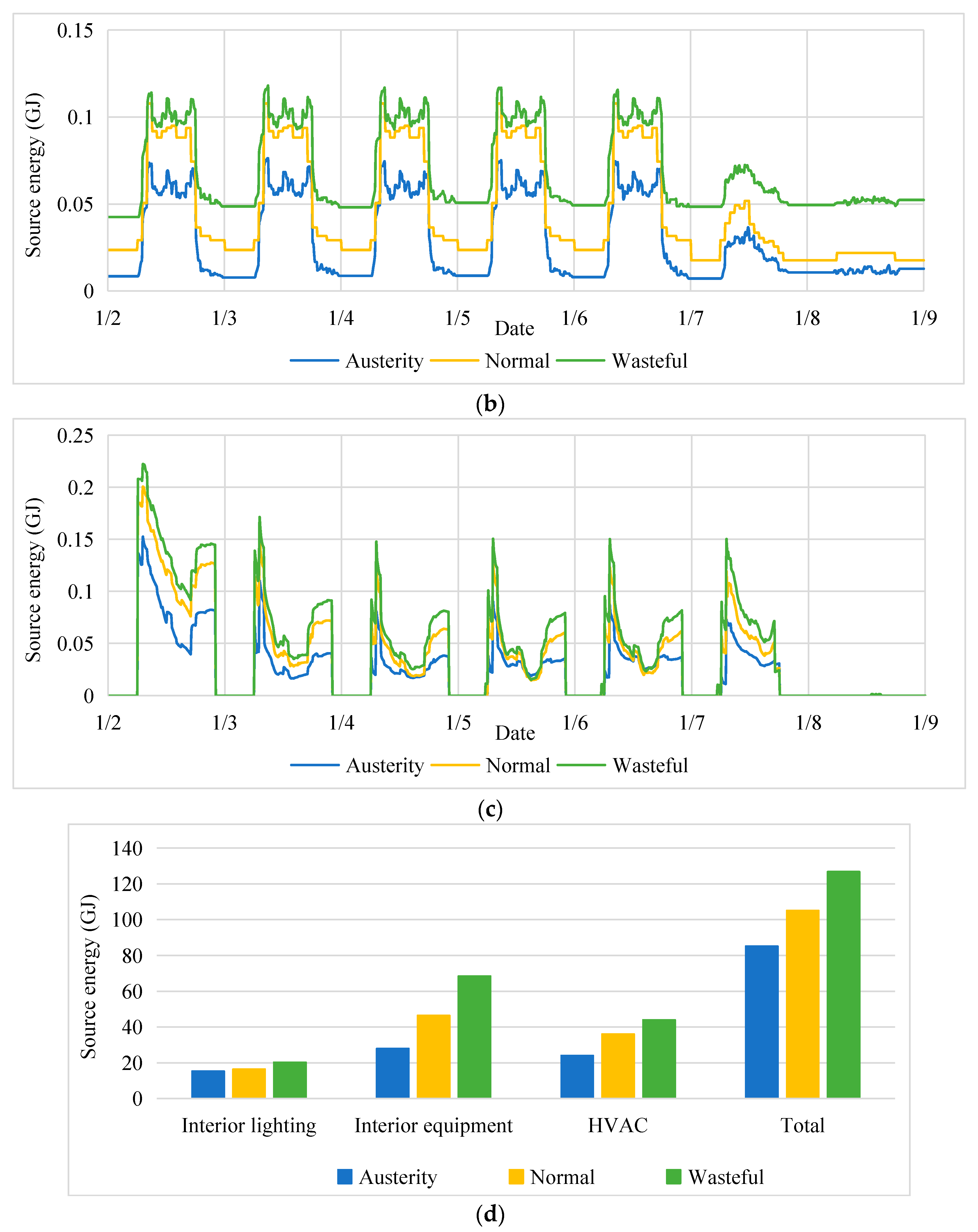
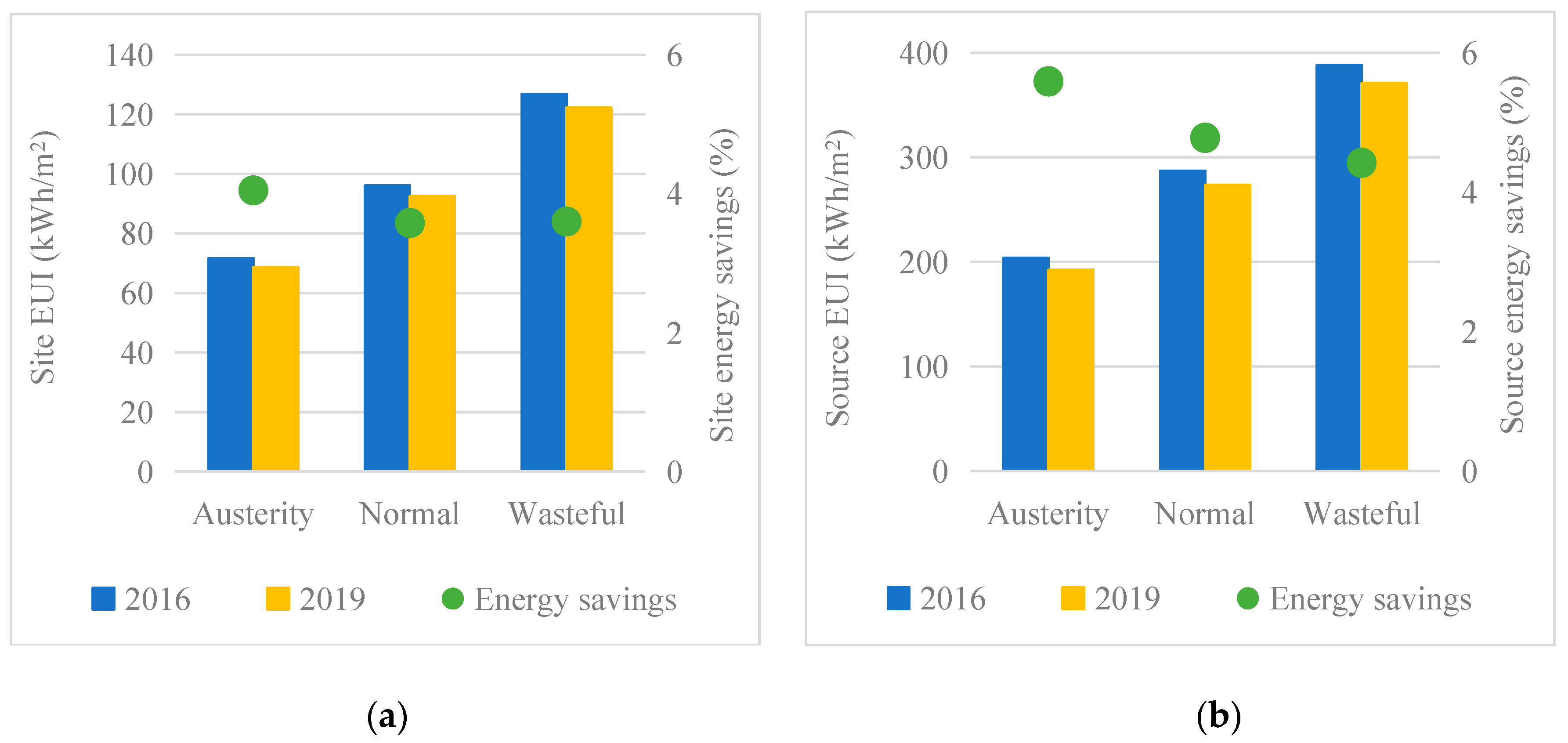
| Climate Zone | Thermal Climate Zone Name | Representative City |
|---|---|---|
| 1A | Very Hot Humid | Honolulu, HI |
| 2A | Hot Humid | Tampa, FL |
| 2B | Hot Dry | Tucson, AZ |
| 3A | Warm Humid | Atlanta, GA |
| 3B | Warm Dry | El Paso, TX |
| 3C | Warm Marine | San Diego, CA |
| 4A | Mixed Humid | New York, NY |
| 4B | Mixed Dry | Albuquerque, NM |
| 4C | Mixed Marine | Seattle, WA |
| 5A | Cool Humid | Buffalo, NY |
| 5B | Cool Dry | Denver, CO |
| 5C | Cool Marine | Port Angeles, WA |
| 6A | Cold Humid | Rochester, MN |
| 6B | Cold Dry | Great Falls, MO |
| 7 | Very Cold | International Falls, MN |
| 8 | Subarctic/Arctic | Fairbanks, AK |
| Zone | Area (m2) | Room Type | Space Number | Occupant Number per Space | Total Occupant Number per Zone | Movement Behavior ID * |
|---|---|---|---|---|---|---|
| F1C | 984.67 | Office | 16 | 4 | 64 | S1 |
| F2C | 984.67 | Other | 5 | 0 | 0 | S1 |
| F3C | 984.67 | Office | 16 | 4 | 64 | S2; S2_Sat |
| F3N | 207.58 | Office | 4 | 4 | 16 | M |
| F3E | 131.41 | Office | 3 | 4 | 12 | S2; S2_Sat |
| F3S | 207.58 | Other | 2 | 0 | 0 | M |
| F3W | 131.41 | Office | 3 | 4 | 12 | S2; S2_Sat |
| F1N | 207.58 | Office | 4 | 4 | 16 | M |
| F1E | 131.41 | Office | 3 | 4 | 12 | M |
| F1S | 207.58 | Office | 4 | 4 | 16 | S3; S3_Sun |
| F1W | 131.41 | Office | 3 | 4 | 12 | A2 |
| F2N | 207.58 | Office | 4 | 4 | 16 | A2 |
| F2E | 131.41 | Office | 3 | 4 | 12 | A1 |
| F2S | 207.58 | Meeting room | 2 | 0 | 0 | A1 |
| F2W | 131.41 | Office | 3 | 4 | 12 | A1 |
| Event Type | Space Category | Occupancy Schedule | Weekdays | Saturday | Sunday, Holiday, Other | |
|---|---|---|---|---|---|---|
| S1, S2, S3, M, A1 | A2 | S2_Sat | S3_Sun | |||
| Random movement event | Own office | Percent time presence | 66% | 66% | 66% | 55% |
| Duration (min) | 90 | 90 | 90 | 90 | ||
| Other office | Percent time presence | 5% | 5% | 5% | 5% | |
| Duration (min) | 30 | 30 | 30 | 30 | ||
| Meeting room | Percent time presence | 20% | 20% | 20% | 20% | |
| Duration (min) | 60 | 60 | 60 | 60 | ||
| Other rooms | Percent time presence | 5% | 5% | 5% | 5% | |
| Duration (min) | 20 | 20 | 20 | 20 | ||
| Outdoor | Percent time presence | 4% | 4% | 4% | 15% | |
| Duration (min) | 10 | 10 | 10 | 10 | ||
| Status transition event | Arrival | Time | 6:00–9:00 | 6:00–9:00 | 6:00–9:00 | 5:00–7:00 |
| Short-term leaving | Early occur time | 12:00 | 12:00 | |||
| Typical occur time | 12:25 | 12:25 | ||||
| Typical duration (min) | 45 | 45 | ||||
| Minimum duration (min) | 20 | 20 | ||||
| Departure | Time | 16:30–18:30 | 22:30–23:30 | 11:00–20:00 | 17:00–19:00 | |
| Meeting Event | Day of Week | Number of Occupants per Meeting | Number of Meetings per Day | Meeting Duration (Hour) | Probability |
|---|---|---|---|---|---|
| 1 | Monday, Friday | 2–21 | 2–5 | 0.5 | 0.12 |
| 1 | 0.72 | ||||
| 1.5 | 0.12 | ||||
| ≥2 | 0.04 | ||||
| 2 | Tuesday, Wednesday, Thursday | 2–21 | 3–7 | 0.5 | 0.12 |
| Occupant Behavior | Austerity | Normal | Wasteful |
|---|---|---|---|
| Control of lights | When people leave the room and it is empty, the lights are turned off. When people stay in the room, lights are turned off if sensed bright and turned on if sensed dark. | The standard schedule is followed. | When people leave the room for more than six hours and it is empty, the lights are turned off. The lights are always turned on during working hours. |
| Control of appliance | 48% of the total plug loads are turned on during working hours, and 8% of the total plug loads are on standby after people leave work. | The standardschedule is followed. | 100% of the total plug loads are turned on during working hours, and 61% of the total plug loads are on standby after people leave work. |
| Thermostat setpoint | 19 °C Heating/26 °C Cooling | 21 °C Heating/24 °C Cooling (The standard schedule is followed.) | 22 °C Heating/23 °C Cooling |
| Equipment Type | Austerity | Wasteful | ||||
|---|---|---|---|---|---|---|
| Working Hours (on) | Leaving Less than 1 h (Standby) | Leaving More than 1 h (Standby) | Leaving Work (Off) | Getting off Work (Standby) | Working Hours (on) | |
| Monitors (W) | 48 | 0 | 0 | 0 | 0 | 96 |
| Computers (W) | 164 | 16 | 16 | 0 | 176 | 252 |
| Water heater (W) | 38 | 38 | 38 | 0 | 60 | 98 |
| Others (W) | 90 | 90 | 90 | 45 | 90 | 90 |
| Total (W) | 340 | 144 | 144 | 45 | 326 | 536 |
| Percentage of total power | 63% | 27% | 27% | 8% | 61% | 100% |
| Climate Zone | Weighting Factors (%) | EUI (kWh/m2) | Energy Savings (%) | ||||
|---|---|---|---|---|---|---|---|
| 2016 Site | 2016 Source | 2019 Site | 2019 Source | Site | Source | ||
| 1A | 3.47 | 108.22 | 335.82 | 103.76 | 321.70 | 4.12 | 4.20 |
| 2A | 14.03 | 101.78 | 315.31 | 98.23 | 303.78 | 3.49 | 3.66 |
| 2B | 4.79 | 96.75 | 298.88 | 92.84 | 285.92 | 4.04 | 4.34 |
| 3A | 13.70 | 94.43 | 288.70 | 90.01 | 272.93 | 4.68 | 5.46 |
| 3B | 11.88 | 90.23 | 275.93 | 87.04 | 264.27 | 3.54 | 4.23 |
| 3C | 2.31 | 81.07 | 249.48 | 77.19 | 236.80 | 4.79 | 5.08 |
| 4A | 19.14 | 94.59 | 278.71 | 91.46 | 264.89 | 3.31 | 4.96 |
| 4B | 0.66 | 87.06 | 263.67 | 84.39 | 252.23 | 3.07 | 4.34 |
| 4C | 3.14 | 81.09 | 243.04 | 78.07 | 229.97 | 3.72 | 5.38 |
| 5A | 16.50 | 99.69 | 283.49 | 97.01 | 269.11 | 2.69 | 5.07 |
| 5B | 5.78 | 90.74 | 267.15 | 87.81 | 253.73 | 3.23 | 5.02 |
| 5C | 0.17 | 79.94 | 237.21 | 77.27 | 224.30 | 3.34 | 5.44 |
| 6A | 3.47 | 112.35 | 309.50 | 108.24 | 291.97 | 3.66 | 5.66 |
| 6B | 0.50 | 97.30 | 276.17 | 93.91 | 260.48 | 3.48 | 5.68 |
| 7 | 0.33 | 98.28 | 294.70 | 91.88 | 272.74 | 6.51 | 7.45 |
| 8 | 0.17 | 107.17 | 310.67 | 99.81 | 285.21 | 6.87 | 8.20 |
| National average | 100 | 96.11 | 287.15 | 92.67 | 273.48 | 3.58 | 4.78 |
| Climate Zone | Weighting Factors (%) | EUI (kWh/m2) | Energy Savings (%) | ||||
|---|---|---|---|---|---|---|---|
| 2016 Site | 2016 Source | 2019 Site | 2019 Source | Site | Source | ||
| 1A | 3.47 | 76.94 | 236.76 | 72.30 | 222.07 | 6.03 | 6.20 |
| 2A | 14.03 | 72.45 | 222.12 | 69.43 | 211.65 | 4.17 | 4.71 |
| 2B | 4.79 | 68.29 | 207.80 | 65.06 | 196.49 | 4.73 | 5.44 |
| 3A | 13.70 | 68.31 | 202.51 | 65.07 | 190.28 | 4.73 | 6.04 |
| 3B | 11.88 | 64.16 | 190.24 | 61.72 | 180.41 | 3.81 | 5.17 |
| 3C | 2.31 | 56.13 | 169.49 | 53.03 | 158.53 | 5.53 | 6.47 |
| 4A | 19.14 | 72.63 | 200.08 | 69.99 | 188.92 | 3.64 | 5.58 |
| 4B | 0.66 | 63.20 | 181.95 | 61.42 | 173.21 | 2.82 | 4.80 |
| 4C | 3.14 | 61.25 | 171.25 | 59.20 | 161.20 | 3.35 | 5.87 |
| 5A | 16.50 | 79.01 | 206.97 | 76.36 | 195.02 | 3.35 | 5.78 |
| 5B | 5.78 | 68.60 | 187.66 | 66.13 | 176.97 | 3.61 | 5.69 |
| 5C | 0.17 | 61.89 | 168.41 | 60.36 | 159.12 | 2.48 | 5.52 |
| 6A | 3.47 | 91.36 | 231.11 | 87.18 | 216.78 | 4.58 | 6.20 |
| 6B | 0.50 | 77.11 | 200.45 | 74.11 | 188.47 | 3.88 | 5.98 |
| 7 | 0.33 | 76.26 | 217.91 | 70.65 | 199.40 | 7.35 | 8.50 |
| 8 | 0.17 | 87.59 | 237.82 | 81.28 | 217.96 | 7.21 | 8.35 |
| National average | 100 | 71.66 | 203.81 | 68.76 | 192.43 | 4.05 | 5.59 |
| Climate Zone | Weighting Factors (%) | EUI (kWh/m2) | Energy Savings (%) | ||||
|---|---|---|---|---|---|---|---|
| 2016 Site | 2016 Source | 2019 Site | 2019 Source | Site | Source | ||
| 1A | 3.47 | 145.51 | 453.93 | 140.40 | 437.73 | 3.52 | 3.57 |
| 2A | 14.03 | 137.59 | 428.79 | 133.32 | 415.18 | 3.10 | 3.17 |
| 2B | 4.79 | 131.86 | 410.42 | 127.10 | 394.87 | 3.61 | 3.79 |
| 3A | 13.70 | 126.36 | 391.61 | 120.47 | 371.69 | 4.66 | 5.09 |
| 3B | 11.88 | 124.07 | 384.46 | 119.51 | 368.89 | 3.68 | 4.05 |
| 3C | 2.31 | 114.30 | 354.97 | 109.09 | 338.26 | 4.56 | 4.71 |
| 4A | 19.14 | 122.46 | 372.98 | 118.26 | 355.91 | 3.43 | 4.58 |
| 4B | 0.66 | 118.87 | 367.11 | 114.74 | 352.03 | 3.47 | 4.11 |
| 4C | 3.14 | 108.84 | 335.03 | 104.27 | 317.88 | 4.20 | 5.12 |
| 5A | 16.50 | 125.63 | 374.27 | 121.84 | 356.20 | 3.02 | 4.83 |
| 5B | 5.78 | 120.05 | 365.50 | 115.82 | 348.31 | 3.53 | 4.70 |
| 5C | 0.17 | 106.85 | 327.77 | 102.49 | 310.61 | 4.08 | 5.24 |
| 6A | 3.47 | 137.35 | 398.75 | 132.59 | 377.82 | 3.47 | 5.25 |
| 6B | 0.50 | 123.68 | 367.81 | 119.08 | 347.92 | 3.72 | 5.41 |
| 7 | 0.33 | 126.17 | 385.43 | 118.20 | 358.90 | 6.31 | 6.88 |
| 8 | 0.17 | 132.22 | 394.72 | 123.34 | 364.27 | 6.71 | 7.71 |
| National average | 100 | 126.83 | 388.33 | 122.27 | 371.28 | 3.60 | 4.42 |
| Building Design Parameters | 90.1-2004 | 90.1-2010 | 90.1-2016 | 90.1-2019 |
|---|---|---|---|---|
| Air infiltration flow per exterior surface area (m3/s)/m2 | 0.001024 | 0.000569 | 0.000569 | 0.000569 |
| VAV DX cooling coil COP | 3.23 | 3.40 | 3.40 | 3.40 |
| Windows SHGC | 0.39 | 0.40 | 0.36 | 0.36 |
| Windows conductance (W/m2·K) | 3.24 | 2.90 | 2.16 | 2.05 |
Publisher’s Note: MDPI stays neutral with regard to jurisdictional claims in published maps and institutional affiliations. |
© 2022 by the authors. Licensee MDPI, Basel, Switzerland. This article is an open access article distributed under the terms and conditions of the Creative Commons Attribution (CC BY) license (https://creativecommons.org/licenses/by/4.0/).
Share and Cite
He, Y.; Chen, Y.; Chen, Z.; Deng, Z.; Yuan, Y. Impacts of Occupant Behavior on Building Energy Consumption and Energy Savings Analysis of Upgrading ASHRAE 90.1 Energy Efficiency Standards. Buildings 2022, 12, 1108. https://doi.org/10.3390/buildings12081108
He Y, Chen Y, Chen Z, Deng Z, Yuan Y. Impacts of Occupant Behavior on Building Energy Consumption and Energy Savings Analysis of Upgrading ASHRAE 90.1 Energy Efficiency Standards. Buildings. 2022; 12(8):1108. https://doi.org/10.3390/buildings12081108
Chicago/Turabian StyleHe, Yaling, Yixing Chen, Zhihua Chen, Zhang Deng, and Yue Yuan. 2022. "Impacts of Occupant Behavior on Building Energy Consumption and Energy Savings Analysis of Upgrading ASHRAE 90.1 Energy Efficiency Standards" Buildings 12, no. 8: 1108. https://doi.org/10.3390/buildings12081108
APA StyleHe, Y., Chen, Y., Chen, Z., Deng, Z., & Yuan, Y. (2022). Impacts of Occupant Behavior on Building Energy Consumption and Energy Savings Analysis of Upgrading ASHRAE 90.1 Energy Efficiency Standards. Buildings, 12(8), 1108. https://doi.org/10.3390/buildings12081108







